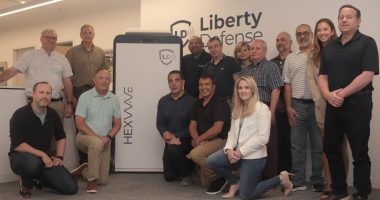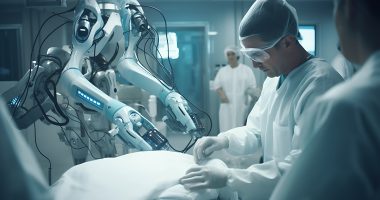Welcome to the Market Herald Top Line. I’m Brieanna McCutcheon, reporting from Downtown Vancouver.
AMPD is a next-generation infrastructure company looking to reinvent the internet to support low-latency applications in an environmentally conscious way.
Rather than offering clients already made solutions, its team engages with customers to understand their technology and infrastructure businesses. In short, AMPD brings experience from its range of partner vendors to construct solutions to match the needs of studios, the already existing pipeline of that company, or the current project at hand.
Today, we are joined by the CEO and Director of the mentioned company Anthony Brown.
TMH: With TIFF just finishing in Toronto and understanding that the entertainment industry is a multi-billion dollar industry, what solutions can AMPD offer?
AB: It’s an awfully big industry, and TIFF really is only a segment of the digital content creation industry. If you look at it as a whole, for example, the video game industry is about a $150 billion industry, and it’s a little bit bigger than film, television and music combined. So when you start to look at the industry holistically and say digital media or content creation and then you start to think about, oh what’s the content creation as far as the metaverse is concerned. John Riccitiello, he’s the CEO over at Unity, and he’s basically predicting that every person that has a 2D website today is going to have a 3D metaverse hub by 2030. So if you take a look at the idea of content creation holistically, not just for film, television, movies, that sort of thing but as a whole, digital twinning, video games, 3D websites, and experiences, it is a gigantic when you’re saying billions, we’re talking hundreds of billions of dollars are involved in digital content creation, and really that is what AMPD supplies but as far as TIFF is concerned specifically, basically we’re here in town taking a look at various different studios meeting with industry professionals and prospective clients about what type of content they’re creating. It’s been fantastic.
We got to see a bunch of different developments that are happening in Toronto and the surrounding area. We got to see some studios as far out from Toronto as Hamilton and Sault Ste. Marie. There are lots of great, interesting projects that are on the way out here, and TIFF is kind of an excuse to get all of those industry professionals in one place and be able to have, well, it’s been kind of back-to-back meetings over the last week, just getting to talk to them about all of their various projects and what their initiatives are. So it’s been fantastic. It’s been a really great event for us.
TMH: What are you able to offer as far as improved quality to other solutions currently available, and how does this affect the cost?
AB: The way I would describe it is that AMPD is building the world’s best suite of tools and technologies for digital content creation. So what can we do? Well, pretty much everything. The first thing we have is the AMPD Virtual Studio Suite that runs on our at-the-edge infrastructure or a high-performance computing infrastructure, this next generation of digital infrastructure that we feel is going to solely take over. The way that we do our cloud computing with that technology, we’re able to give a digital content creator working from home the power of whole studio access from his desk at home. So, we start there, and it starts with the computing and the type of computing that’s required to make all this digital content. Then, of course, with Departure Lounge, we’re able to bring the real world into the metaverse or into the digital realities by using the world’s largest, highest-resolution volumetric capture stage, which we just finished building in Vancouver.
So we’re able to bring live performances of people into the metaverse into video games, into movies and on television in full volumetric 3D through this stage. We also have markerless motion capture ability to do motion capture without having to wear those weird suits with the little white dots on them, and we use machine learning to be able to work that out. We could even do motion capture off of old footage, for example, and be able to bring motion capture from something that happened 20 years ago into the metaverse as well as object capture – all of that sort of stuff. That’s really where Departure Lounge comes in, is being able to bring the real world into the metaverse. Lastly, we have virtual production, which is a giant paradigm shift when it comes to how movies and television are made.
One of the more popular series that really highlighted the use of virtual production is Star Wars: The Mandalorian. What they did is because of how powerful these real-time rendering engines have become, like Unreal Engine, which is what you play Fortnite on, by the way, they became so powerful that as long as you have enough computing behind it, you’re able to have a photorealistic scene displayed on a giant LED wall and then shoot everything on camera. So imagine you’ve got a director, cinematographer, an actor, and instead of being in front of a green screen, somebody holding a tennis ball on the end of a stick or something for the actor to interact with, they actually have all the visual effects, the whole environment, the characters, the creatures, et cetera, all there in camera and the director can actually make changes. He can change the time of day or move a mountain all while the actors and cinema cinematographers, cameramen and everything are right there. The impact on the industry for that is absolutely immense, and we’re really seeing everything from location shoots to real and unreal location shoots. So you could be like on a spaceship, or you could be in Versai, and you can do this all on an LED wall. It’s really exciting technology. We’re very excited about partnering with Versatile Media on that technology and, again, the world’s best.
TMH: It really sounds too good to be true almost because you can do so much with it.
AB: It is kind of perfect timing, but it is something that we’ve been doing for a very long time. My previous company, I had a company called Seven Group that I ran, and I started in 2000, and we were building studio infrastructure for all the major name brands, Disney, Technicolour, Universal, EA and Ubisoft and so on, for years and years, and so really, it’s just an evolution of that technology but as they say, every overnight success is like 20 years in the making or something. So it’s kind of convergence, really, we’re very lucky to be in a position to be able to provide the best computing in the world with the best capture technology in the world with the best virtual production technology in the world, all under one roof, all at a time when digital content creators need to work from home thanks to COVID and all of the changes that occurred there. The dawn of virtual production, the dawn of the metaverse where content creation is exploding. It’s growing exponentially, just think how many millions of web pages have to get converted into 3D volumetric assets. So yeah, we couldn’t have a better product at a better time, I guess.
TMH: Are these solutions applicable in other industries besides entertainment?
AB: Yeah. Digital content creation is, as I say, not limited to film, television, and video games. It includes things like digital twins, being able to make full digital representations of buildings or manufacturing plants or airplanes or cars. It’s used in healthcare, making digital twins of humans and actually being able to train on digital cadavers, basically. It applies to almost anything in which you would like to have a 3D representation of something and then the math behind it. It’s one thing, for example, to create a visual representation of a manufacturing plant for example.
AMPD has worked on a digital twin of an aerospace manufacturing plant, and it was really important to have all of the math to be able to simulate the composite manufacturing process that they were going through. So that in the digital twin, it actually has all of that physics and math and everything behind it, and so the computing that we provide can do all of those things. For example, we’ve done artificial intelligence used for COVID therapeutic research, looking at new molecules for COVID therapeutics. That’s with Variational AI, a company we announced over a year ago. Digital twining, as I mentioned, we did an aerospace manufacturing plant and another big one that we announced recently we’ve signed a binding MOU with a company called Unleash Future Boats (UFB). The team at UFB has developed autonomous hydrogen electric boats, and the same computing that we use to do virtual production and artificial intelligence is also being used to create the digital twin of the environment that the boats are driving in to be able to guide those boats autonomously as they drive around and so we’re deploying those in our AMPD Ultimate Edge containers for the Unleash Future Boats project. Of course, assuming that the German government is going ahead with the project, which of course means, assume they are, but that part hasn’t been announced yet.
TMH: With greener solutions being a focus for everyone, you are currently working on self-driving, zero emissions fully electric, hydrogen-powered boats. Can you update us on this project in Germany?
AB: Sure. What we’d be looking at is a $1.8 million proof of concept or paid proof of concept. So we’d be doing a small port in Germany and supporting, I believe it’s 40 boats that they would be initially deploying in that port. With our computing infrastructure, we would deploy that infrastructure in what we call the AMPD Ultimate Edge containers. Sometimes the communication between, say, the boat and the shore has to be so fast that you can’t just put it in a data center somewhere. You have to put it right near where the computing needs to be done. The closer the computing is to the people using it, the faster it goes. The latency is the key there, and so we’re able to deploy this infrastructure in basically modified C Cans that we built and can host the high-performance computing required for UFB. As far as the green nature of computing, that doesn’t only apply to what Unleash Future Boats is doing with their autonomous zero-emission boats, but it applies to all the types of computing we do. So for example, one of our products that are used for digital content creation is the AMPD Virtual Workstation. This is where a digital content creator, an artist gets access to all the power of a studio from his desk at home but the way we do that is we have one server that can service up to 16 people off of one server in our environment with the same power that they would have if they were using their individual workstation under their desk.
So, that means about 68-75% power savings per seat per person in the amount of power we consume, and it also means the amount of manufactured goods required. We have one server as opposed to buying 16 workstations with 16 CPUs and 16 GPUs, and 16 hard drives. You’re just buying one server, and so it’s inherently greener because you’re creating fewer components, you’re manufacturing fewer goods, you’re using fewer precious metals, and then on top of that, you get all the power saving. And then, of course, when it’s in the AMPD data center, we use the excess heat generated from those servers to heat the surrounding buildings. So, there are multiple ways in which this needs to be looked at since how we do this is not only technically powerful but in a greener way. If you take a look at what’s been going on with Bitcoin mining and the impact on the environment of that kind of stuff. We have to take that into consideration, especially considering everybody’s going to have 3D websites and everyone’s going to be wearing AR glasses and there’s going to be a lot of computing going on. We need to do it in a much greener way than it has been so far.
TMH: Thank you for sharing this insightful information today, is there anything else you want to touch on before we finish up here today?
AB: We recently closed a private placement. I’d like to thank all the investors that came to support AMPD on that private placement. We’re very excited about things that are coming down the pipeline. Recently in August, we had the big event at SIGGRAPH, where we did the grand opening of Departure Lounge with its volumetric capture stage and other technologies and demonstrated it to everybody. Also, at the conference, we launched the AMPD Virtual Studio Suite running in three countries and two continents, and we did demos of working on the same asset at the same time from around the world on our platform. From that launch at SIGGRAPH, we’re now dealing with all of the very eager customers that are interested in the technology. So there’s going to be lots of stuff to happen over the next few weeks, lots of announcements to make, and we’re looking forward to coming and seeing you again, Brieanna.
Thanks again for joining us, Anthony.
We’ve been speaking with Anthony Brown, CEO and Director of AMPD. You can follow the company on the CSE under the symbol AMPD.
For regular updates, visit https://ampd.tech/.
I’m Brieanna McCutcheon for The Market Herald. Thanks for watching.
FULL DISCLOSURE: This is a paid article produced by The Market Herald.



